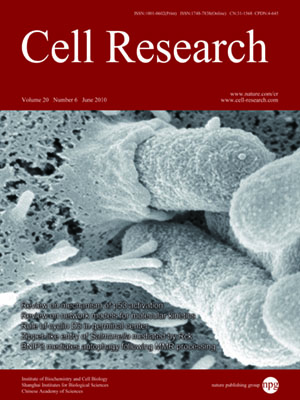
Volume 20, No 6, Jun 2010
ISSN: 1001-0602
EISSN: 1748-7838 2018
impact factor 17.848*
(Clarivate Analytics, 2019)
Volume 20 Issue 6, June 2010: 631-646
ORIGINAL ARTICLES
Requirement for cyclin D3 in germinal center formation and function
Jonathan U Peled1, J Jessica Yu1, Jeganathan Venkatesh2, Enguang Bi1, B Belinda Ding1,5, Melissa Krupski-Downs1, Rita Shaknovich3, Piotr Sicinski4, Betty Diamond2, Matthew D Scharff1 and B Hilda Ye1
1Department of Cell Biology, Albert Einstein College of Medicine, 1300 Morris Park Avenue, Bronx, NY 10461, USA
2The Center for Autoimmune and Musculoskeletal Disease, The Feinstein Institute for Medical Research, Manhasset, NY 11030, USA
3Departments of Medicine and Pathology, Weill Cornell College of Medicine, New York, NY 10021, USA
4Department of Cancer Biology, Dana-Farber Cancer Institute, and Department of Pathology, Harvard Medical School, Boston, MA 02115, USA
5Current address: Department of Anatomy and Cell Biology, University of Kansas Medical Center, Kansas City, KS 66160, USA
Correspondence: B Hilda Ye,(hilda.ye@einstein.yu.edu)
Germinal centers (GC) of secondary lymphoid tissues are critical to mounting a high-affinity humoral immune response. B cells within the GC undergo rapid clonal expansion and selection while diversifying their antibody genes. Although it is generally believed that GC B cells employ a unique proliferative program to accommodate these processes, little is known about how the GC-associated cell cycle is orchestrated. The D-type cyclins constitute an important component of the cell cycle engine that enables the cells to respond to physiological changes. Cell type- and developmental stage-specific roles of D-type cyclins have been described but the cyclin D requirement during GC reaction has not been addressed. In this study, we report that cyclin D3 is largely dispensable for proliferation and Ig class switching of
in vitro activated B cells. In contrast, GC development in
Ccnd3−/− mice is markedly impaired, as is the T cell-dependent antibody response. Within the GC, although both switched and unswitched B cells are affected by cyclin D3 inactivation, the IgM
− pool is more severely reduced. Interestingly, despite a compensatory increase in cyclin D2 expression, a significant number of
Ccnd3−/− GC B cells accumulate in quiescent G0 state. Lastly, although cyclin D3 inactivation did not disrupt BCL6 expression in GC B cells, it completely blocked the GC promoting effect of BCL6 overexpression, suggesting that cyclin D3 acts downstream of BCL6 to regulate GC formation. This is the first demonstration that cyclin D3 plays an important and unique role at the GC stage of B cell development.
Cell Research (2010) 20:631-646. doi:10.1038/cr.2010.55; published online 20 April 2010
FULL TEXT | PDF
Browse 2260


